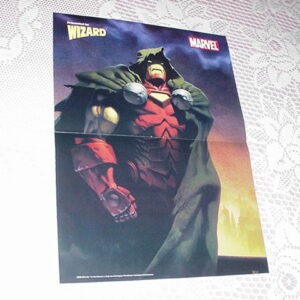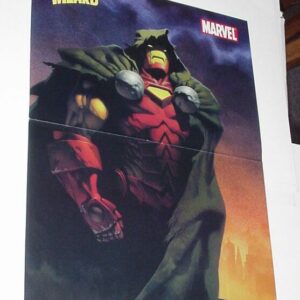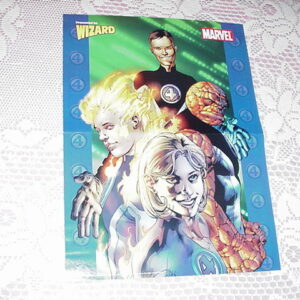Batman Poster #24 FRAMED Batgirl Robin Detective Comics #359 (1967) Carmine Infantino
$74.99
Description
You are purchasing the item pictured, framed. Priority mail, tracking and $50 insurance is included with purchase. Item will be bagged to protect from dust, packed in packing peanuts and boxed. Just open box and hang it on the wall…makes a perfect gift!
Nine months before making her television premiere on “Batman” a new Batgirl appeared in the pages of Detective Comics and would become one of the more popular characters to emerge from the Silver Age of Comics. Yet the idea for the debut of Barbara Gordon, according to editor Julius Schwartz, was attributed to the television series executives’ desires to have a character that would appeal to a female audience and for this character to originate in the comics. Hence, writer Gardner Fox and artist Carmine Infantino collarborated on “The Million Dollar debut of Batgirl!” Barbara Gordon was a brainy librarian with a brown belt in judo. She was nothing like her teenage predecessor, Betty Kane, who relished being a hero; in fact, the daughter of Police Commissioner Gordon only donned a Batgirl costume for a policeman’s masquerade ball. However, when she stumbled upon an attempt on the life of millionaire Bruce Wayne by Killer Moth, Barbara sprang into action, fending off the attackers and feeling a crime-fighting spirit awaken within her. The spirit awakened again following what appeared to be Wayne’s murder at the hands of the Killer Moth. Unfortunately, Batgirl soon discovered that “Wayne” was a dummy set up by Batman and Robin to draw out Killer Moth, and her arrival had interfered with the operation. Though dejected, Batgirl quickly made amends for her rookie mistakes, tracking Killer Moth to his hideout and rescuing the Dynamic Duo from a gravity free chamber that made them helpless targets. She had been wearing perfume during their previous tussle and some had rubbed off on Killer Moth. She was even able to scent down the criminal mastermind when he attempted to evade capture. The Caped Crusader told the impressive Batgirl that he would welcome her help whenever the need arose, though she wasn’t the type to wait for an invitation. Furthermore she was intent on refuting the perception of the “weaker sex” and refused to take a back seat to anyone. Although she partnered with TV’s Dynamic Duo for only one season, Batgirl became a regular fixture in future comic book adventures. Batgirl is the name of several fictional characters appearing in comic books published by DC Comics, depicted as female counterparts to the superhero Batman. Although the character Betty Kane was introduced into publication in 1961 by Bill Finger and Sheldon Moldoff as Bat-Girl, she is replaced by Barbara Gordon in 1967, who later came to be identified as the iconic Batgirl. Her creation came about as a joint project between DC Comics editor Julius Schwartz and the producers of the 1960s Batman television series. In order to boost ratings for the third season of Batman, the producers requested a new female character be introduced into publication that could be adapted into the television series. At Schwartz’s direction, Barbara Gordon debuted in Detective Comics #359 titled, “The Million Dollar Debut of Batgirl!” (1967) by writer Gardner Fox and artist Carmine Infantino. Depicted as the daughter of Gotham City police commissioner James Gordon, her civilian identity is given a doctorate in library science and she is employed as head of Gotham City Public Library, as well as later being elected to the United States Congress. As Batgirl, the character operates primarily in Gotham City, allying herself with Batman and the original Robin Dick Grayson, as well as other prominent heroes in the DC Universe. While the introduction of Batgirl into the Batman television series failed to save it from cancellation, her comic book counterpart gained popularity and makes regular appearances in Detective Comics, Batman Family and several other books produced by DC until 1988. That year, she appears in Barbara Kesel’s Batgirl Special #1, in which she retires from crime-fighting. She subsequently appears in Alan Moore’s graphic novel Batman: The Killing Joke where, in her civilian identity, she is shot through the spinal cord by the Joker and left paraplegic. Although she is recreated as the computer expert and information broker Oracle by editor Kim Yale and writer John Ostrander the following year, her paralysis sparked debate about the portrayal of women in comics, particularly violence depicted toward female characters. Schwartz stated that he had been asked to develop a new female character in order to attract a female viewership to the Batman television series of the 1960s. When producers William Dozier and Howie Horowitz saw rough concept artwork of the new Batgirl by artist Carmine Infantino during a visit to DC offices, they optioned the character in a bid to help sell a third season to the ABC television network. Infantino reflected on the creation of Batgirl, stating “Bob Kane had had a Bat-Girl for about three stories in the ’50s but she had nothing to do with a bat. She was like a pesky girl version of Robin. I knew we could do a lot better, so Julie and I came up with the real Batgirl, who was so popular she almost got her own TV show.” Yvonne Craig portrayed the character in the show’s third season. Barbara Gordon and alter ego Batgirl debuted in Detective Comics #359, “The Million Dollar Debut of Batgirl” (1967), as the daughter of Gotham City’s Police Commissioner James Gordon. In the debut story, while driving to a costume ball dressed as a female version of Batman, Barbara Gordon intervenes in a kidnapping attempt on Bruce Wayne by the super villain Killer Moth, attracting Batman’s attention and leading to a crime-fighting career. Although Batman insists she give up crime-fighting because of her gender, Batgirl disregards his objections. In her civilian identity, Dr. Barbara Gordon Ph.D. is depicted as a career woman with a doctorate in library science, as well as being head of Gotham City public library, “presumably one of the largest public libraries in the DC Comics version of reality.” Barbara Gordon’s Batgirl exceeded the earlier Bat-Girl and Batwoman characters in popularity, and readers requested for her to appear in other titles. Although some readers requested that Batwoman also continue to appear in publication, DC responded to the fan-based acclaim and criticism of the new character in an open letter in Detective Comics #417 (1971), stating: “I’d like to say a few words about the reaction some readers have to Batgirl. These are readers who remember Batwoman and the other Bat-girls from years back … They were there because romance seemed to be needed in Batman’s life. But thanks to the big change and a foresighted editor, these hapless females are gone for good. In their place stands a girl who is a capable crime-fighter, a far cry from Batwoman who constantly had to be rescued by Batman.” Carmine Michael Infantino (May 24, 1925 – April 4, 2013) was an American comic book artist and editor who was a major force in the Silver Age of Comic Books. He was inducted into comics’ Will Eisner Award Hall of Fame in 2000. Infantino’s first published work for DC was “The Black Canary”, a six-page Johnny Thunder story in Flash Comics #86 (Aug. 1947) that introduced the superheroine the Black Canary. Infantino’s long association with the Flash mythos began with “The Secret City” a story in All-Flash #31 (Oct.-Nov. 1947). He additionally became a regular artist of the Golden Age Green Lantern and the Justice Society of America. During the 1950s, Infantino freelanced for Joe Simon and Jack Kirby’s company, Prize Comics, drawing the series Charlie Chan. Back at DC, during a lull in the popularity of superheroes, Infantino drew Westerns, mysteries, science fiction comics. In 1956, DC editor Julius Schwartz assigned writer Robert Kanigher and artist Infantino to the company’s first attempt at reviving superheroes: an updated version of the Flash that would appear in issue #4 (Oct. 1956) of the try-out series Showcase. Infantino designed the now-classic red uniform with yellow detail (reminiscent of the original Fawcett Captain Marvel), striving to keep the costume as streamlined as possible, and he drew on his design abilities to create a new visual language to depict the Flash’s speed, making the figure a red and yellow blur. The eventual success of the new, science-fiction-oriented Flash heralded the wholesale return of superheroes, and the beginning of what fans and historians call the Silver Age of comics. Infantino drew “Flash of Two Worlds,” a landmark story published in The Flash #123 (Sept. 1961) that introduced Earth-Two, and more generally the concept of the multiverse, to DC Comics.
>PAN>Frame is shrinkwrapped until time of purchase. Ships boxed with packing peanuts.
THE PERFECT GIFT!
Related products
-


Iron Man Poster # 5 by Kev Walker Iron Doom Exiles 23 Cover
$29.99 Add to cart -


Ultimate Fantastic Four Poster # 1 Bryan Hitch Reed Johnny Sue Ben
$39.99 Add to cart -


Punisher Poster # 6 by Wieslaw Walkuski Born Frank Castle Origin Movie
$29.99 Add to cart -


Captain America Poster # 9 In Chains by John Cassaday Issue 8
$29.99 Add to cart




